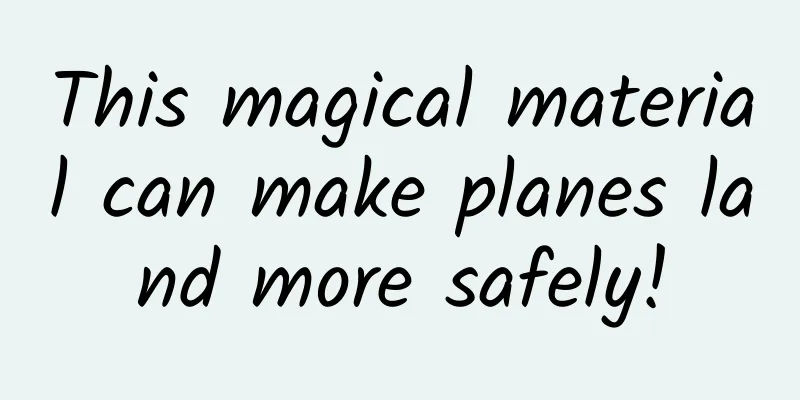This magical material can make planes land more safely!

|
An airplane is a very complex means of transportation. It is not only large and heavy, but also flies very fast. In order to land it safely, many parts of the airplane need to work together closely, and one of the most critical parts is the brake pad. When an airplane lands, it has to reduce its speed to zero on a limited runway. At this time, the brake pads are subjected to huge friction and a high temperature of about 1000 degrees Celsius caused by friction. If it encounters rain, snow, sand and dust, the "test" it faces will be even greater. At present, carbon/carbon composite materials are undoubtedly the best choice! You may find this name a bit strange. Why are there two "carbon" characters? Is it a typo? That's right. The first "carbon" refers to carbon fiber, and the second "carbon" refers to the carbon matrix. They are combined into a "team", which not only plays their respective advantages, but also produces a magical effect of 1+1>2. If carbon/carbon composites are compared to reinforced concrete, then the carbon fibers can be seen as the steel bars, while the carbon matrix is the concrete that bonds and protects the carbon fibers. Carbon/carbon composite materials are not only light and high temperature resistant, but also wear-resistant, high-strength and long-life. Compared with other materials of the same weight, their load-bearing capacity is also superior. Therefore, people often use them in aerospace and other fields. The brake pads on our domestically produced large aircraft C919 are made of them. Not only aircraft brake pads, but also manned spacecraft, rockets, missiles and other aircraft, especially future high-speed aircraft, cannot do without carbon/carbon composite materials. When an aircraft flies in the atmosphere, it will produce friction with the atmosphere, causing the temperature of the aircraft surface to rise. If it flies in the atmosphere at a very high speed, the friction between its outer surface and the atmosphere will be more intense, resulting in a temperature of more than 2000 degrees Celsius. At such a temperature, ordinary materials will quickly melt or even vaporize, causing the aircraft to disintegrate. Carbon/carbon composite materials are currently an indispensable choice to solve this problem. Because at ultra-high temperatures, they not only do not melt, but also continue to maintain their unique excellent "abilities". Let me tell you, our Shenzhou series of manned spacecraft use them! Did you know that carbon/carbon composite materials are so powerful, but my country has never developed them? In the 1980s, my country could only import aircraft from abroad. The brake pads on aircraft were easily worn and needed to be replaced regularly. However, at that time, we did not have the technology to prepare carbon/carbon composite materials, let alone produce such brake pads, so we had to spend a lot of money to buy them from abroad. Because carbon/carbon composite materials have unique and excellent capabilities, various rockets and missiles cannot do without them, so foreign countries restrict their export. As a result, not only can we buy brake pads this time, but we cannot guarantee them for the next time, and face the possibility of "supply cut" at any time, and the material preparation technology is strictly blocked. At that time, China was controlled by others in this field. This situation worried scientist Huang Boyun, who was determined to make a carbon/carbon brake material with Chinese characteristics. So he led his team to start decades of research. At first, there was no information to refer to, so they could only cross the river by feeling the stones and keep trying. Each experiment cycle lasted for several months. During this period, they opened the furnace door every few dozen days, took out samples, tested various indicators, processed them and put them back into the furnace, anxiously waiting for the results. In summer, Changsha, Hunan, where they are located, often has a high temperature of nearly 40 degrees Celsius, making it a veritable "furnace city". The furnace they use for experiments has an internal temperature of more than 1,000 degrees Celsius, and the temperature in the laboratory is often as high as 50 degrees Celsius or even higher. Huang Boyun and his team braved the heat to persist in their research, and when they couldn't stand the heat anymore, they went outside to "cool down". However, in the first few years, all they harvested was a pile of black carbon blocks that they themselves could not understand, and they could only conduct experiments again and again... At the critical moment of the experiment, Huang Boyun fell ill and needed surgery. He had just finished the surgery and rushed back to the laboratory without taking a rest. With such hard work, they finally made what they thought was a good sample in September 2000. So they conducted a simulated braking test with great expectations, but it failed! After 12 years, they had used up all the tricks they could think of and were extremely frustrated. Huang Boyun said that it was the "darkest and most painful days". But he could not give up, he had to sort out his mood and lead the team to re-engage in the difficult research work. He said to everyone: "It is impossible for scientific research to be without failure. Failure is not terrible. The key is not to give up easily. We must find the symptoms and prescribe the right medicine. We must do this project well, even if it costs our lives!" Thanks to everyone's efforts, a high-performance aviation brake material with good efficiency and low cost - carbon/carbon composite material was finally born in their hands, and the "shackles" that were holding the neck were finally opened! After 20 years of countless experiments, Huang Boyun's team finally printed the word "China" on this "hard bone" in the world's material field. He was also selected as one of the "People Who Moved China•2005"! Today, Huang Boyun's team is still seeking new breakthroughs. They have developed a more magical upgraded version of carbon/carbon composite materials with an operating temperature of over 3000 degrees Celsius. Life never stops, and scientific research never stops! The mysterious world of carbon/carbon is waiting for you to explore; more magical materials are waiting for your creation and invention. From now on, keep going! Source: Chongqing Industry-University-Research Cooperation Promotion Association Author: Pan Fusheng, Academician of the Chinese Academy of Engineering, Professor of Chongqing University, Chairman of Chongqing Association for Science and Technology Review expert: Mao Yi, chief expert of Chongqing Science Communication Expert Group, professor of Chongqing Electronic Engineering Vocational College Statement: Except for original content and special notes, some pictures are from the Internet. They are not for commercial purposes and are only used as popular science materials. The copyright belongs to the original authors. If there is any infringement, please contact us to delete them. |
<<: Do you think they glow just for the sake of beauty? They are just "talking"!
Recommend
How can this "cheap" metal support the industrial backbone of our motherland?
1. The metal with the largest production and usag...
Shangqiu SEO Training: Traffic has dropped drastically, how to self-check and recover?
Recently, I received a response from a VIP site. ...
There are so many advertising channels, how do you choose?
Faced with the intensified competition of product...
Brand marketing promotion: Understand advertising creation skills from 3 aspects!
When it comes to "advertising creation"...
How to use public account data? It is enough to analyze these 4 points!
The WeChat public account backend contains detail...
How to operate during the product stable period
A reader asked how he could make a breakthrough a...
The National Day routine is here, I won’t tell ordinary people about it!
The annual National Day holiday is coming! Are yo...
2017 Mobile Map App Research Report: Which is the best among Amap, Baidu and Tencent?
Author's opinion As of December 2017, the use...
It's not your fault if you can't say the words! Learn more about the "tip of the tongue phenomenon"
...
From today on, don’t post these on your Moments! The maximum fine is ¥100,000!
Has your circle of friends become cluttered with ...
If you are not good at physics, please do not click on this article
Remember this fairy-like iced food in the restaur...
What are the functions of the photography applet? How much does it cost to create a professional photography app?
Everyone's exposure to photography is differen...
Wan Qing's "A Hot Wealth Creation Course That Everyone Can Copy" A Simple and Practical Guide to Wealth [MP3/33.0MB]
"Wan Qing's "A Simple and Practical...
Brightness is 50 times higher than the previous record. Chinese satellite accurately measures the brightest gamma-ray burst to date
Science and Technology Daily reporter Lu Chengkua...
Build a community that can sell goods and make money in 5 days, so that customers + orders will grow explosively, and earn more than 50,000 yuan per month (with information package)
Build a community that can sell goods and make mo...









